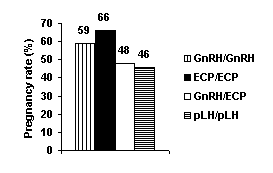Dairy heifers must be inseminated at 14 to 15 months of age in order to achieve the target age of 24 months at calving. Sure sounds easy, but is this always possible in real life? Dairy producers have many chores involving the milking herd leaving little time for reproductive management of replacement heifers. As a result, timely detection of estrus and insemination do not occur in many heifers. A controlled breeding protocol that allows fixed-time breeding without estrus detection is therefore desirable.
The Ovsynch protocol for synchronizing ovulation is popular and effective for fixed-time breeding programs in dairy cows. In this 10-day protocol, GnRH (gonadotropin releasing hormone) is given on Day 0 (e.g. Monday), followed by Prostaglandin F2a (PGF) a week later on Day 7, (next Monday). A second GnRH is given two days later (on Day 9, Wednesday) and the cows are bred 16 hours later (on Day 10, Thursday). Despite being effective in cows, the average pregnancy rate is only around 40% in heifers, considerably lower than what could be achieved with breeding at detected estrus. In addition, some heifers display estrus during the period of the Ovsynch protocol. Consequently, timed-breeding is often performed after ovulation has occurred, thereby reducing the chances of pregnancy.
A practical method of preventing the early onset of estrus in heifers is to include progesterone in the Ovsynch protocol. An intravaginal progesterone device, known as the Controlled Internal Drug Release device (CIDR, Vetrepharm Inc.), is currently on the market but little information is available on the efficacy of CIDR-based protocols for fixed-time breeding in dairy heifers.
We have recently completed a research project to determine if cheaper or more efficient alternatives to GnRH are available for use in CIDR-based controlled breeding protocols. We compared pregnancy rates in heifers treated with: GnRH (Fertiline, Vetoquinol NA Inc.), porcine luteinizing hormone (pLH; Lutropin-V, Vetrepharm Inc.), estradiol cypionate (ECP, Pharmacia Animal Health), or a GnRH/ECP combination in a CIDR-based Ovsynch protocol.
We used 240 13-14 month old cycling heifers in two research herds, to compare pregnancy rates in the four different CIDR-based fixed-time breeding protocols as described in Table 1. Results are presented in Figure 1.
Table 1. Protocol schedule for the four experimental treatments.
| Treatment (no. of heifers) |
Day of Protocol | ||||
| 0 | 7 | 8 | 9 | 10 | |
| GnRH/GnRH(63) | CIDR insertedGnRH, 100mg | PGF, 25 mg | CIDR removed | GnRH, 100mg | A.I. |
| ECP/ECP(56) | CIDR inserted ECP, 0.5 mg | PGF, 25 mg | CIDR removed ECP 0.5 mg | None | A.I. |
| GnRH/ECP(60) | CIDR insertedGnRH, 100mg | PGF, 25 mg | CIDR removed ECP 0.5 mg | None | A.I. |
| pLH/pLH(61) | CIDR insertedpLH,12.5 mg | PGF, 25 mg | CIDR removed | pLH, 12.5 mg | A.I. |
Though a greater proportion of heifers assigned to the ECP/ECP protocol was determined pregnant, the pregnancy rate did not differ significantly from that of the GnRH/GnRH treated heifers. However, pregnancy rate of heifers in the ECP/ECP group was higher than that in the GnRH/ECP (P=0.05) and pLH/pLH (P=0.02) groups.
Under our experimental conditions, a CIDR-based Ovsynch/fixed-time breeding protocol using ECP at a low dose of 0.5 mg yielded pregnancy rates comparable to those obtained with GnRH, with lower costs and with heifers handled four times instead of five. Though the incorporating of a CIDR device into the Ovsynch protocol looks attractive, it adds significantly to the cost of the protocol. There is a cost advantage to using ECP, but extreme caution must be exercised with this product because in doses higher than the 0.5 to 1.0 mg range, it could lead to excessive (and prolonged) estrogen levels in the blood of heifers. This could impair reproductive function, at least temporarily. This new protocol needs further testing with a larger number of heifers.
Figure 1. Pregnancy rates to fixed-time insemination of dairy heifers after synchronization of ovulation with four different CIDR-based protocols.
This research was conducted simultaneously at the Dairy Research and Technology Centre, Edmonton and at the UBC Dairy Education and Research Centre, Agassiz. Dr. Divakar Ambrose is a Dairy Research Scientist with Alberta Agriculture, Food and Rural Development in Edmonton. Dr. John Kastelic is a Research Scientist at the Lethbridge Research Centre of Agriculture and Agri-Food Canada. Muhammad Aali is a graduate student in Animal Science at UBC, Nelson Dinn is the Manager of the Dairy Centre and Dr. Raja Rajamahendran is a Professor of Animal Science at UBC.
Financial support for this research was provided by Alberta Milk Producers and the Alberta Agricultural Research Institute. In-kind contributions by Pharmacia Animal Health (Lutalyse, ECP), Vetoquinol NA Inc. (Fertiline) and Vetrepharm Inc. (CIDR, Lutropin-V) are acknowledged.
